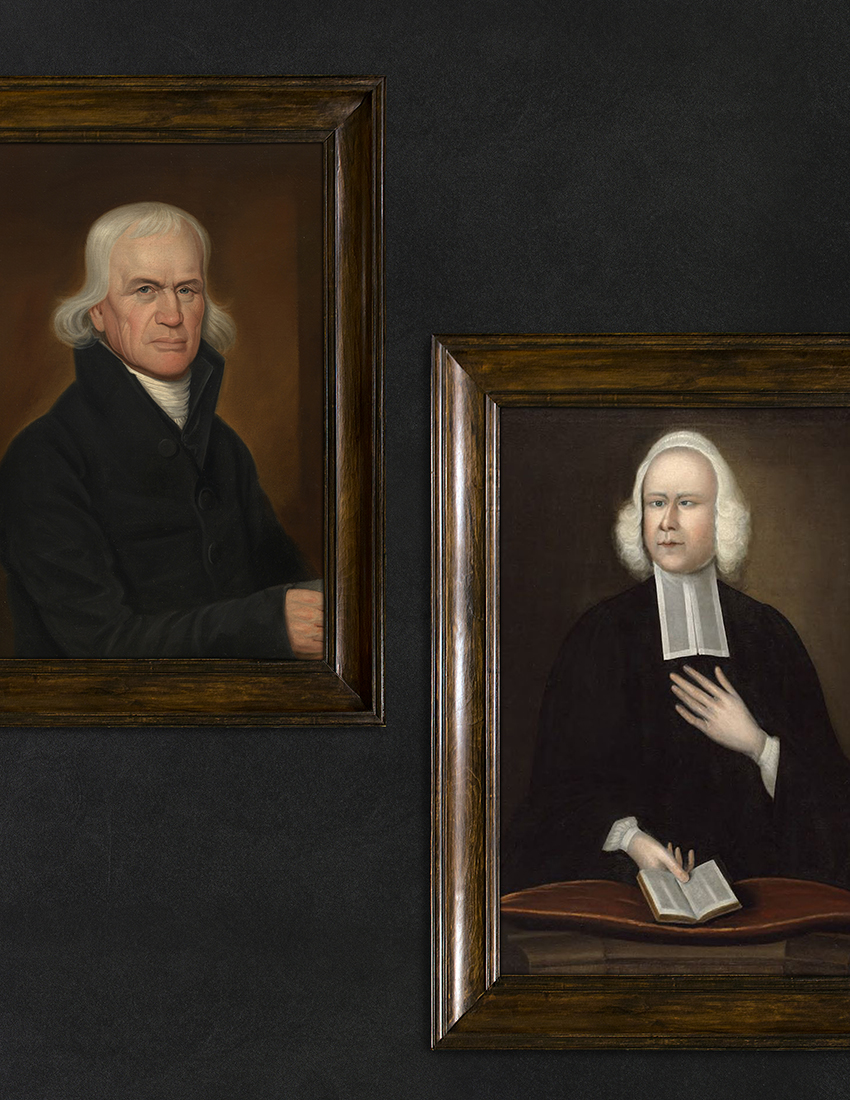
ABOUT THE ART
Paradise, John. Francis Asbury (1745-1816). 1813. Oil on canvas. 76.2cm x 61cm. National Portrait Gallery, Smithsonian Institution. (Portrait on left side) Badger, Joseph. George Whitefield (1714-1770). 1745. Oil on canvas. 106.5 x 83.5 cm. Harvard University Portrait Collection, Gift of Mrs. H. P. (Sarah H.) Oliver to Harvard College, 1852. Harvard Art Museums. (Portrait on right side)
Francis Asbury and George Whitfield – November 15th
Francis Asbury (1745-1816) and George Whitefield (1714-1770) were evangelists, early Methodists, and founders of American Evangelicalism.
George Whitefield (sometimes spelled Whitfield) was one of the first to join John Wesley’s group, which became known as Methodists. In fact, Whitefield taught Wesley to preach outdoors, which helped build the movement in Bristol, England. While a Methodist, Whitefield differed with Wesley, embracing the theology of Calvinism and tolerating slavery. Whitefield devoted his life to founding the Bethesda Orphanage in Georgia and was known as a firebrand preacher who could inspire the multitudes. He preached to millions of people in his life, especially in America, where he was a prominent leader in the Great Awakening.
Bishop Francis Asbury was also a leader in the Great Awakening and a Methodist from England. When Wesley was making assignments of preaching circuits, Asbury volunteered for the circuit named simply “America.” He likely preached to as many people as Whitefield, but instead of drawing large crowds, he took the message on the road, riding an average of 6,000 miles a year. He was the first Methodist Bishop to be ordained in America and was its leader for 32 years. He petitioned George Washington to end slavery, and he founded schools and countless churches. Asbury and Whitefield, so similar and yet so different, contributed to the stream of religious life in the new world, which we now call American Evangelicalism.
To remember Whitefield, we are having throat coat tea, the perfect pairing for a weary voice. Tea with lemon juice, honey, and spices, this beverage will soothe the throat and warm the soul. And if you want your tea to really pack a punch, add a shot of whisky.
To remember Asbury and the many miles he traveled to share the good news, we are recommending journey cakes. The Methodist circuit riders found this portable food suitable for their long journeys between missions. The corn journey cake, or Johnny cake, was a Native American staple. It is basically fried cornbread and is traditionally served like pancakes with butter and cane syrup or honey.
These two recipes will keep your voice strong and give you strength to get wherever you may be going!

Journey Cakes (aka Johnny Cakes)
4
servings5
minutes15
minutes200
kcalJourney Cakes, also known as johnny cakes, are a type of flatbread made from cornmeal, salt, and water. They are a traditional food in many Caribbean countries, as well as in parts of the Southern United States. The name "Johnny Cake" is said to have originated from the early American explorers, who carried the ingredients for the cakes with them on long journeys. When it was time to eat, they would mix the ingredients together and cook the cakes over an open flame, hence the name "journey cakes." Today, Johnny Cakes are often served as a breakfast food or as a side dish to a main meal.
Keep the screen of your device on
Ingredients
1 cup stone-ground cornmeal
3 teaspoons sugar
1/2 teaspoon salt
2 1/2 cups water
2 tablespoons unsalted butter
butter or oil for frying
Directions
- Whisk together the cornmeal, salt, and sugar in a mixing bowl. Meanwhile in a large saucepan, bring the water to a boil. Add the cornmeal mixture into the boiling water, whisking constantly. Turn off the heat and continue whisking until the mixture is smooth. Add the butter and continue whisking until melted and incorporated. Let the batter rest for 15 minutes.
- Heat a cast iron over medium-high heat. Melt some butter or oil in the pan. Using a 1/4 cup scoop, drop the batter onto the pan. Let the cakes fry undisturbed for several minutes until the edges are browned. Avoid flipping them too soon or they will fall apart.
- Once the edges are browned, flip the cakes over. Use the spatula to press the journey cake down to a thickness of no more than 1/4 inch. Continue to fry until the cakes are golden brown and crispy.
- Let the cakes cool slightly and then enjoy with butter and maple syrup.